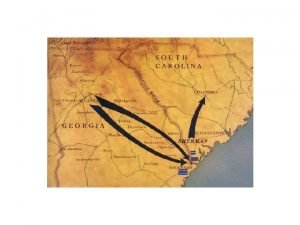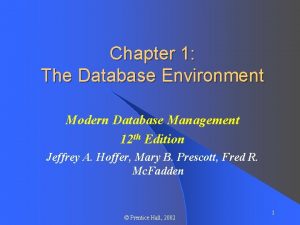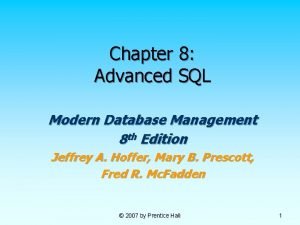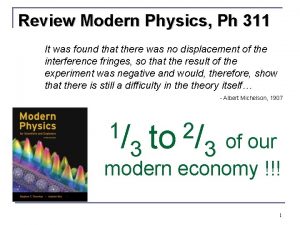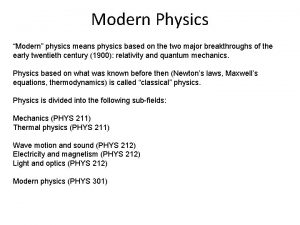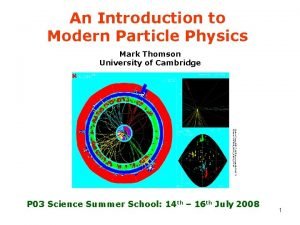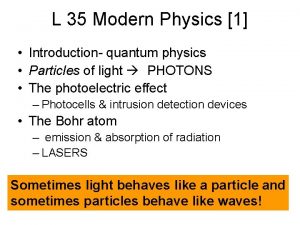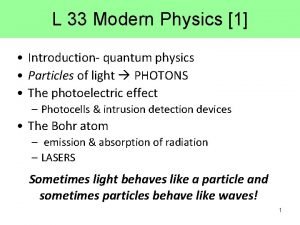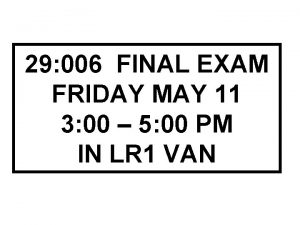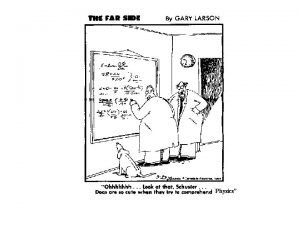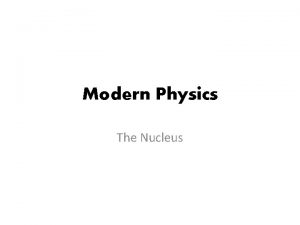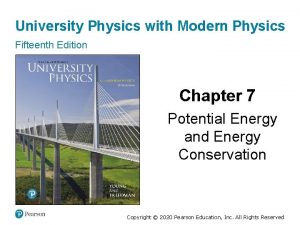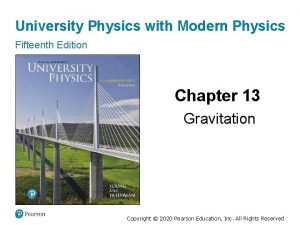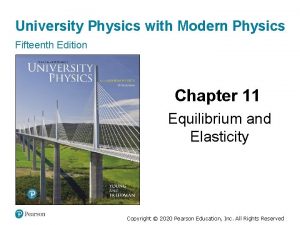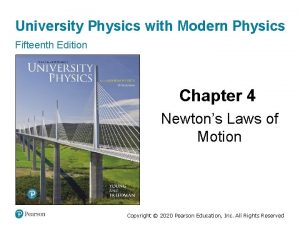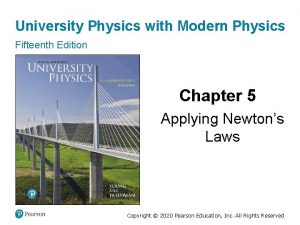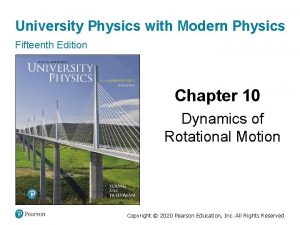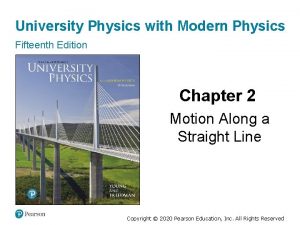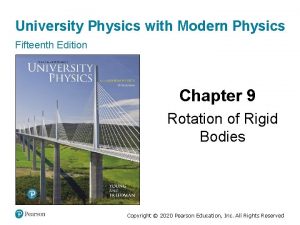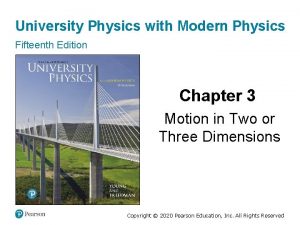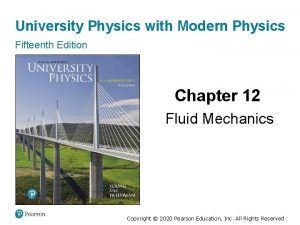University Physics with Modern Physics Fifteenth Edition Chapter
































- Slides: 32

University Physics with Modern Physics Fifteenth Edition Chapter 1 Units, Physical Quantities, and Vectors Copyright © 2020 Pearson Education, Inc. All Rights Reserved

Learning Outcomes In this chapter, you’ll learn… • the four steps you can use to solve any physics problem. • three fundamental quantities of physics and the units physicists use to measure them. • how to work with units and significant figures in your calculations. • how to add and subtract vectors graphically, and using vector components. • two ways to multiply vectors: the scalar (dot) product and the vector (cross) product. Copyright © 2020 Pearson Education, Inc. All Rights Reserved

The Nature of Physics • Physics is an experimental science in which physicists seek patterns that relate the phenomena of nature. • The patterns are called physical theories. • A very well established or widely used theory is called a physical law or principle. Copyright © 2020 Pearson Education, Inc. All Rights Reserved

Solving Problems in Physics • All of the Problem-Solving Strategies and Examples in this book will follow these four steps: • Identify the relevant concepts, target variables, and known quantities, as stated or implied in the problem. • Set Up the problem: Choose the equations that you’ll use to solve the problem, and draw a sketch of the situation. • Execute the solution: This is where you “do the math. ” • Evaluate your answer: Compare your answer with your estimates, and reconsider things if there’s a discrepancy. Copyright © 2020 Pearson Education, Inc. All Rights Reserved

Idealized Models To simplify the analysis of a) a baseball in flight, we use b) an idealized model. Copyright © 2020 Pearson Education, Inc. All Rights Reserved

Standards and Units • Length, time, and mass are three fundamental quantities of physics. • The International System (SI for Système International) is the most widely used system of units. • In SI units, length is measured in meters, time in seconds, and mass in kilograms. Copyright © 2020 Pearson Education, Inc. All Rights Reserved

Unit Prefixes • Prefixes can be used to create larger and smaller units for the fundamental quantities. Some examples are: • • • (size of some bacteria and living cells) (a 10 -minute walk) (mass of a grain of salt) (mass of a paper clip) (time for light to travel 0. 3 m) Copyright © 2020 Pearson Education, Inc. All Rights Reserved

Unit Consistency and Conversions • An equation must be dimensionally consistent. Terms to be added or equated must always have the same units. (Be sure you’re adding “apples to apples. ”) • Always carry units through calculations. • Convert to standard units as necessary, by forming a ratio of the same physical quantity in two different units, and using it as a multiplier. • For example, to find the number of seconds in 3 min, we write: Copyright © 2020 Pearson Education, Inc. All Rights Reserved

Uncertainty and Significant Figures • The uncertainty of a measured quantity is indicated by its number of significant figures. • For multiplication and division, the answer can have no more significant figures than the smallest number of significant figures in the factors. • For addition and subtraction, the number of significant figures is determined by the term having the fewest digits to the right of the decimal point. • As this train mishap illustrates, even a small percent error can have spectacular results! • Video Tutor Solution: Example 1. 3 Copyright © 2020 Pearson Education, Inc. All Rights Reserved

Vectors and Scalars • A scalar quantity can be described by a single number. • A vector quantity has both a magnitude and a direction in space. • In this book, a vector quantity is represented in boldface italic type with an arrow over it: • The magnitude of is written as A or Copyright © 2020 Pearson Education, Inc. All Rights Reserved

Drawing Vectors • Draw a vector as a line with an arrowhead at its tip. • The length of the line shows the vector’s magnitude. • The direction of the line shows the vector’s direction. Copyright © 2020 Pearson Education, Inc. All Rights Reserved

Adding Two Vectors Graphically (1 of 3) Copyright © 2020 Pearson Education, Inc. All Rights Reserved

Adding Two Vectors Graphically (2 of 3) Copyright © 2020 Pearson Education, Inc. All Rights Reserved

Adding Two Vectors Graphically (3 of 3) Copyright © 2020 Pearson Education, Inc. All Rights Reserved

Adding More Than Two Vectors Graphically (1 of 3) • To add several vectors, use the head-to-tail method. • The vectors can be added in any order. Copyright © 2020 Pearson Education, Inc. All Rights Reserved

Adding More Than Two Vectors Graphically (2 of 3) • To add several vectors, use the head-to-tail method. • The vectors can be added in any order. Copyright © 2020 Pearson Education, Inc. All Rights Reserved

Adding More Than Two Vectors Graphically (3 of 3) • To add several vectors, use the head-to-tail method. • The vectors can be added in any order. Copyright © 2020 Pearson Education, Inc. All Rights Reserved

Subtracting Vectors Copyright © 2020 Pearson Education, Inc. All Rights Reserved

Multiplying a Vector by a Scalar • If c is a scalar, the product has magnitude • The figure illustrates multiplication of a vector by a) a positive scalar and b) a negative scalar. Copyright © 2020 Pearson Education, Inc. All Rights Reserved

Addition of Two Vectors at Right Angles • To add two vectors that are at right angles, first add the vectors graphically. • Then use trigonometry to find the magnitude and direction of the sum. • In the figure, a cross-country skier ends up 2. 24 km from her starting point, in a direction of 63. 4 degrees east of north. Copyright © 2020 Pearson Education, Inc. All Rights Reserved

Components of a Vector • Adding vectors graphically provides limited accuracy. Vector components provide a general method for adding vectors. • Any vector can be represented by an x-component Ax and a y-component Ay. Copyright © 2020 Pearson Education, Inc. All Rights Reserved

Positive and Negative Components • The components of a vector may be positive or negative numbers, as shown in the figures. Copyright © 2020 Pearson Education, Inc. All Rights Reserved

Finding Components • We can calculate the components of a vector from its magnitude and direction. • Video Tutor Solution: Example 1. 6 Copyright © 2020 Pearson Education, Inc. All Rights Reserved

Calculations Using Components • We can use the components of a vector to find its magnitude and direction: • We can use the components of a set of vectors to find the components of their sum: • Refer to Problem-Solving Strategy 1. 3. Copyright © 2020 Pearson Education, Inc. All Rights Reserved

Unit Vectors • A unit vector has a magnitude of 1 with no units. • The unit vector points in the +x-direction, points in the +y points in -direction, and the +z-direction. • Any vector can be expressed in terms of its components as Copyright © 2020 Pearson Education, Inc. All Rights Reserved

The Scalar Product (1 of 2) Copyright © 2020 Pearson Education, Inc. All Rights Reserved

The Scalar Product (2 of 2) • The scalar product can be positive, negative, or zero, depending on the angle between Copyright © 2020 Pearson Education, Inc. All Rights Reserved

Calculating a Scalar Product Using Components • In terms of components: • The scalar product of two vectors is the sum of the products of their respective components. Copyright © 2020 Pearson Education, Inc. All Rights Reserved

Finding an Angle Using the Scalar Product • Example 1. 10 shows how to use components to find the angle between two vectors. Copyright © 2020 Pearson Education, Inc. All Rights Reserved

The Vector Product If the vector product (“cross product”) of two vectors is The direction of the vector product can be found using the right-hand rule: Copyright © 2020 Pearson Education, Inc. All Rights Reserved

The Vector Product is Anticommutative Copyright © 2020 Pearson Education, Inc. All Rights Reserved

Calculating the Vector Product • Use to find the magnitude and the right-hand rule to find the direction. • Refer to Example 1. 11. • Video Tutor Solution: Example 1. 11 Copyright © 2020 Pearson Education, Inc. All Rights Reserved
 University physics with modern physics fifteenth edition
University physics with modern physics fifteenth edition Performance appraisal in human resource management
Performance appraisal in human resource management Human resources department structure
Human resources department structure Chapter 12 worlds of the 15th century
Chapter 12 worlds of the 15th century The worlds of the fifteenth century
The worlds of the fifteenth century Caneton roti accompaniment
Caneton roti accompaniment What does rally round the flag mean
What does rally round the flag mean Modern physics vs classical physics
Modern physics vs classical physics Using mis 10th edition
Using mis 10th edition Using mis (10th edition)
Using mis (10th edition) Modern labor economics 12th edition solution
Modern labor economics 12th edition solution Vertical economics
Vertical economics Modern real estate practice in pennsylvania 14th edition
Modern real estate practice in pennsylvania 14th edition Modern database management 12th edition ppt
Modern database management 12th edition ppt Database management system environment
Database management system environment Modern operating systems 3rd edition
Modern operating systems 3rd edition Modern operating systems tanenbaum 5th edition
Modern operating systems tanenbaum 5th edition Modern database management 8th edition
Modern database management 8th edition Modern systems analysis and design 7th edition
Modern systems analysis and design 7th edition Modern database management solutions
Modern database management solutions Modern labor economics 12th edition
Modern labor economics 12th edition College physics explore and apply 2nd edition answers
College physics explore and apply 2nd edition answers Review of modern physics
Review of modern physics Document
Document Mark thomson particle physics
Mark thomson particle physics Modern physics introduction
Modern physics introduction Modern physics introduction
Modern physics introduction Modern physics introduction
Modern physics introduction Physics
Physics Physics
Physics 沈榮麟
沈榮麟 Helsinki university physics
Helsinki university physics University physics
University physics






